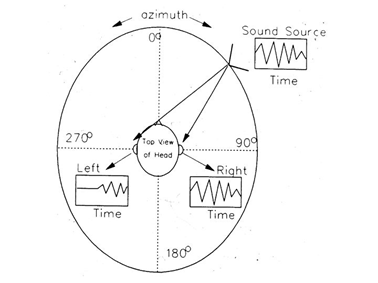Most animals accomplish localization of sounds using Interaural Time Differencing (ITD) and Interaural Level Differencing (ILD). Imagine the sound source in the image below is a balloon popping somewhere out in front of you. The sound from that pop does not travel instantly, so it takes some time for it to wrap around your head. This means that, unless a sound is directly in front of you, the sound will enter one ear before the other.
- ITD: This is the amount of time that passes between when the first ear hears the pop, and when the other ear hears it. Sound moves at about 340 m/s, meaning the ITD will range from 0.000 (s) when a sound source is straight ahead, and 0.001 (s) when the source is at 90°. Likewise, the sound of the pop will be quieter on the side facing away from the balloon.
- ILD: This is this difference in apparent volume between your ears. Both ITD and ILD are used together to determine the location of a sound in the azimuthal plane to within 3°.
The sagittal plane (the vertical axis in the image above) is a little less straight forward, because there is no change in ITD or ILD as a sound source moves up or down. To determine the location of a sound above or below us, we use slight variations in hearing caused by the varying density of our head when viewed from different angles. Acoustic vibrations are conducted differently through our jaw than they are thorough our head from above, resulting in certain frequencies being accentuated or dampened. Using these so called "monaural cues" we are able to approximate the sagittal origin of a sound to within about 20°.
The image below gives a visual summary of these three localization mechanisms.
 Dan Schneider
Dan Schneider

Discussions
Become a Hackaday.io Member
Create an account to leave a comment. Already have an account? Log In.